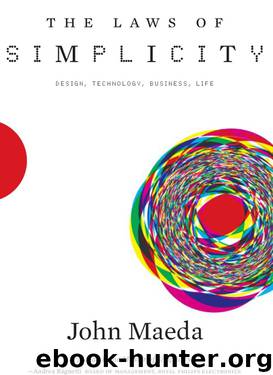Laws Simplicity by John Maeda

Author:John Maeda [John Maeda]
Language: eng
Format: epub
Tags: aVe4EvA
Publisher: MIT Press
Published: 2011-05-21T08:24:57+00:00
Law 6
context
What lies in the periphery of simplicity is definitely not peripheral.
There is something about how our eyes and hands work in concert. Picture yourself at the pottery wheel, sculpting each detail with intense concentration. Everything that matters is happening in the foreground, at your fingertips, and is completely within your immediate field of vision. Your cell phone goes oΩ or the doorbell rings, and this tightest of control loops is disrupted while the background surges into the foreground. Thankfully you notice that a pot on the stove is boiling over, or realize that your hand has been cut and unattendedly bleeds.
While the words “narrowness” and “focus” mean essentially the same thing, the former has a negative connotation while the latter has a positive one. An athlete who reaches the Olympics, for instance, is not “narrow” but focused. But focus isn’t always a good thing.
I was once advised by my teacher Nicholas Negroponte to become a light bulb instead of a laser beam, at an age and time in my career when I was all focus. His point was that you can either brighten a single point with laser precision, or else use the same light to illuminate everything around you. Striving for excellence usually entails the sacrifice of everything in the background for the sake of attending to the all-important foreground. I took Negroponte’s challenge as a greater goal of finding the meaning of everything around, instead of just what I directly faced.
What lies in the periphery of simplicity is definitely not peripheral. The sixth Law emphasizes the importance of what might become lost during the design process. That which appears to be of immediate relevance may not be nearly as important compared to everything else around. Our goal is to achieve a kind of enlightened shallowness. It is befitting that we start this trek by talking about nothing.
NOTHING IS SOMETHING
Science holds that entropy in the universe is always increasing. What does this mean in lay terms? A child opens an illustrated story book, flips through the pictures, and sees an empty part of the page. A crayon clenched in her fist, she moves her hand towards the blank space. What is she likely to do? Fill in the emptiness, of course.
This is the eighth book that I’ve designed and written, but it is the first that I have written more than designed. All designs have upheld the common priority of maximizing “white space”—essentially all these blank areas of the page that surround the text. Such surfaces invite chaos, in the same way that a countertop at home collects change, mail, keys, and so forth. Similarly we might scribble notes in these empty spaces that surround, and also in the gutters that separate lines of text.
Consider the simple challenge of a page that says nothing more than, “Don’t write on this page.” Can you resist the urge? Turn to page 57 and take the test.
The inviting, open space of the page challenges your sense of pride that five written words can hold you in command.
Download
This site does not store any files on its server. We only index and link to content provided by other sites. Please contact the content providers to delete copyright contents if any and email us, we'll remove relevant links or contents immediately.
POP by Steven Heller(3298)
Japanese Design by Patricia J. Graham(3098)
The Power of Broke by Daymond John(2880)
Architecture 101 by Nicole Bridge(2748)
Indistractable: How to Control Your Attention and Choose Your Life by Nir Eyal(2321)
Fusion 360 for Makers by Lydia Sloan Cline(2296)
Batik by Rudolf Smend(2113)
Actionable Gamification: Beyond Points, Badges, and Leaderboards by Yu-kai Chou(2113)
Origami Art by Michael G. Lafosse & Richard L. Alexander(2053)
Homebody by Joanna Gaines(2021)
Whiskey in a Teacup by Reese Witherspoon(1927)
Worn in New York by Emily Spivack(1920)
Feng Shui by Stephen Skinner(1891)
Austin Kleon by Steal Like an Artist(1872)
Simple Gatherings by Melissa Michaels(1840)
Don't Make Me Think, Revisited: A Common Sense Approach to Web Usability by Steve Krug(1814)
Hygge: The Danish Art of Happiness by Marie Tourell Søderberg(1683)
The Joy of Hygge by Jonny Jackson(1670)
The Laws of Simplicity by John Maeda(1558)
